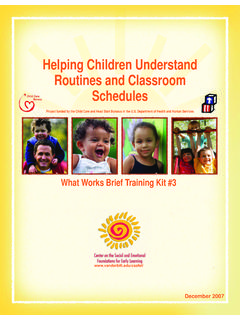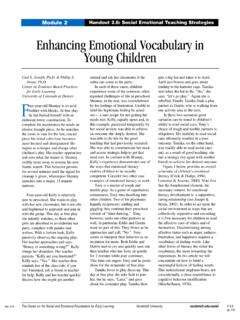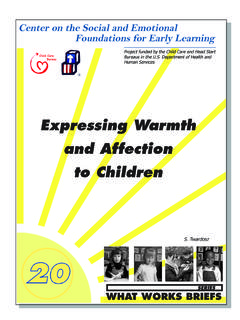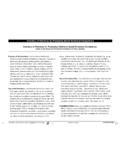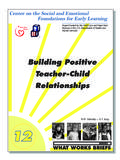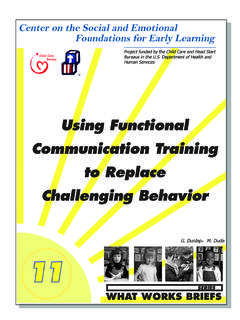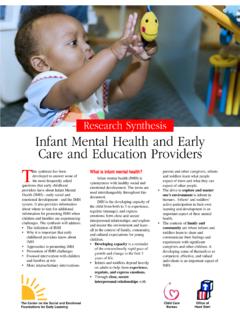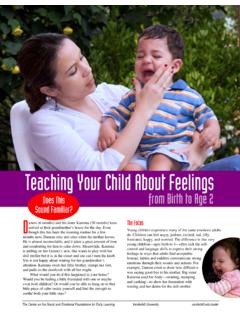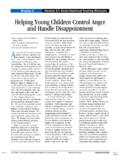Transcription of Building Positive Relationships with Young Children
1 Gail E. Joseph, , & Phillip , on Evidence Based Practicesfor Early LearningUniversity of Colorado at DenverThe fundamental importance ofbuilding Positive relationshipswith Children can be bestillustrated by the following and her 30-month-old daughter,Lucy, have a long-standing morningtradition of going to a neighborhoodpark and playing with other parentsand Children . They spend anywherefrom 1 to 2 hours each day at the day, however, Helen receives anemergency call and needs to return totheir home immediately. She and Lucyhave been at the park for about 10minutes, and Lucy is playing cooks with her best friend Tito. Helen says toLucy, Honey, I m sorry, but you andMommy have to go home right is , but we have togo. Lucy begins to whimper and says, But, I was playing with Tito. Helenreaches down and hugs Lucy, saying, I know. Let s call Tito s mommywhen we get home and invite him overto play later.
2 Lucy says, , andshe and her mom hurry has been a Head Start teacherfor 10 years. In that time, he has built areputation as the teacher for the toughkids. This year, Bill is assigned toEric s class because of Bill s longhistory of hyperactivity, negativity, andaggression toward adults and months into the year, the Center sadministrator sheepishly asks Eric howthings are going with Bill. Eric replies, Great, boy were folks wrong aboutBill. Somewhat flabbergasted, theadministrator decides to see forhimself. What he observes in less that10 minutes is as follows. Eric says toeveryone, Look at Bill, he is sitting soquietly in circle; too cool Bill! WhenBill answers a question about the story,Eric says, Bill, that s right, you arereally concentrating today. Whentransition is about to occur, Eric says, Bill, can you show everyone goodwalking feet to snack? At snack, apeer asks Bill for juice, and he passesthe container.
3 Eric, being vigilant, says, Bill, thanks for sharing so nicely. After completing a functionalbehavior assessment, Erin, an ECSE teacher, determines that Jessie s long-standing tantrum behaviors in the classare designed to acquire adult institutes a plan to ignore Jessie stantrums and to spend as much timeand attention when Jessie is not havinga tantrum. After four days of increasedtantrums, Jessie s behavior hasimproved each of the foregoing scenarios,adults were successful in achievingimproved behavior change in contextsthat many individuals might predictwould lead to continuing, evenescalating challenging , in each case, Children wereobviously attuned to adults, focused ontheir communication, and prone tovalue and seek-out adult approval. In each case, the adults had investedtime and effort prior to the events inquestion, communicating theirnoncontingent affection andunquestioned valuing of these submit that this prior history ofpositive relationship Building is aprerequisite to effective interventionpractices for challenging behavior andthus goal one for adults and caregiverswishing to prevent challengingbehavior and enhance Children s senseof well-being and social does one go about the task ofrelationship Building ?
4 Building Positive RelationshipsBuilding Positive Relationships withyoung Children is an essential task anda foundational component of goodteaching. All Children grow and thrivein the context of close and dependablerelationships that provide love andnurturance, security, and responsiveinteractions. A Positive adult-childrelationship built on trust,understanding, and caring will fosterchildren s cooperation and motivationand increase their Positive outcomes atschool (Webster-Stratton, 1999). In areview of empirically derived risk andprotective factors associated withacademic and behavioral problems atthe beginning of school, Huffman et al.(2000) identified that having a positivepreschool experience and a warm andopen relationship with their teacher orchild care provider are importantprotective factors for Young protective factors operate toproduce direct, ameliorative effects forchildren in at-risk situations (Luthar,1993).
5 Next, we describe some of thekey ingredients for Things FirstUtilizing a relationship -buildingmodel, proper sequencing of adultbehavior is critical. Simply put, adultsneed to invest time and attention withchildren as a precedent to the optimumuse of sound behavior changestrategies. There are two reasons thatthis sequence is so important. First, itBuilding Positive Relationships withYoung ChildrenHandout : Building Relationships and Creating Supportive Environments Module 1 The Center on the Social and Emotional Foundations for Early Learning Vanderbilt H (p. 1/3)Rev. 2/10should be noted that the protectivefactors promoted during relationshipbuilding can and do function to reducemany challenging behaviors. As such,taking the time to do relationshipbuilding may save time that would bespent implementing more elaborate andtime-consuming assessment andintervention strategies. Second, asadults build Positive Relationships withchildren, their potential influence onchildren s behavior growsexponentially.
6 That is, Children cue inon the presence of meaningful andcaring adults, they attend differentiallyand selectively to what adults say anddo, and they seek out ways to ensureeven more Positive attention fromadults (Lally, Mangione, & Honig,1988). It is this Positive relationshipfoundation that allowed Helen withminimal effort to leave the park earlywith Lucy, for Eric to experience Billin a much more Positive way than priorteachers, and for Erin to alter Jessie stantrums in such short to Know YouIn order for adults to buildmeaningful Positive Relationships withchildren, it is essential to gain athorough understanding of Children spreferences, interests, background, andculture. For very Young Children andchildren with special needs, thisinformation is most often accessed byobserving what Children do and byspeaking directly to parents and othercaregivers. With this information,adults can ensure that their play withchildren is fun, that the content of theirconversations is relevant, and that theycommunicate respect for Children sorigins.
7 Whenever possible, this kindof information exchange should be asreciprocal as possible. That is, adultsshould be sharing their own interests,likes, backgrounds, and origins withchildren as well. It Takes a Lot of LoveFor many Children , developingpositive Relationships with adults is adifficult task. Prior negative history andinterfering behavior often conspire tomake the task of relationshipdevelopment long and arduous. Onoccasion then, adults should considerthat they will need to devote extensiveeffort to relationship Building . Theeasiest, most straightforward way toachieve a high level of interventionintensity in the relationship -buildingdomain is to think about embeddingopportunities throughout the day (seelist below for specific suggestions).While there is no magic number thatwe know of, we have seen teacherswho can easily provide several dozenpositive, affirming statements tochildren each day. For Children whohave mostly heard criticism, it takes,we feel, a lot of messages to thecontrary.
8 Making DepositsA metaphor for Building positiverelationships that we find particularlyhelpful is that of a piggy teachers and caregiversengage in strategies to build positiverelationships, it is as if they are making a deposit in a child srelationship piggy bank. Conversely,when adults make demands, nag, orcriticize Children , it is as if they aremaking a relationship withdrawal. Forsome Children , because there has beenno prior effort to make deposits in theirrelationship piggy bank, nagging,criticism, and demands may be moreakin to writing bad checks! It may behelpful to reflect on the interactionsyou have with an individual child andthink to yourself, Am I making adeposit or a withdrawal? Or, Have Imade any deposits in Bill s piggy banktoday? Figures 1 and 2 representexample deposits (Figure 1) in therelationship bank or withdrawals(Figure 2) from the teachers and child careproviders strive to build positiverelationships with all of the Children intheir care.
9 Typically, we have the bestrelationships with Children whorespond to us, seemingly like us, andgo along with our plans. But as youknow, it is more difficult to buildpositive Relationships with somechildren than with others. We have allhad experience with Children who pushour hot buttons. Maybe they demandmore attention than others, aredisruptive, unmotivated, oppositional,aggressive, or do not give us thepositive feedback we get from our hot buttons get pushed, wemay feel frustrated and discouraged, orbad about ourselves as teachers,causing us to get angry, raise ourvoices, criticize, or actively avoid thesechildren. Yet, the very Children we findthe most difficult to build relationshipswith are the ones who need positiverelationships with adults the most! It isa natural reaction to feel emotionalwhen a hot button is pushed. However,rather than feeling frustrated, angry, orguilty about it, it is more productive tothink of the emotional response as awarning sign that you will have towork extra hard to proactively build apositive relationship with this child.
10 Ifthe adult is simply reacting to a hotThe Center on the Social and Emotional Foundations for Early Learning Vanderbilt H (p. 2/3)Figure 1. Making relationship depositsFigure 2. Making relationship withdrawalsRev. 2/10 Handout : Building Relationships and Creating Supportive Environments Module 1 Handout : Building Relationships and Creating Supportive Environments Module 1 button being pushed he or she mayconsistently become frustrated andavoid the child. We recognize thatbuilding Positive Relationships is farfrom simple with some Children . Ittakes a frequently renewedcommitment and consistent this is easier said than done,we have provided some practicalstrategies for Building positiverelationships with Children throughoutthe preschool Strategies for BuildingPositive Relationships Distribute interest surveys thatparents fill out about their child Greet every child at the door byname Follow a child s lead during play Have a conversation over snack Conduct home visits Listen to a child s ideas and storiesand be an appreciative audience Send Positive notes home Provide praise and encouragement Share information about yourselfand find something in common withthe child Ask Children to bring in familyphotos and give them an opportunityto share it with you and their peers Post Children s work Have a Star of the week whobrings in special things from homeand gets to share them during circletime Acknowledge a child s effort Give compliments liberally Call a child s parents to say what
